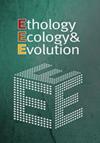Web building behavior in a wall spider (Oecobiidae) suggests a close relationship with orb-weavers
IF 1.3
4区 生物学
Q4 BEHAVIORAL SCIENCES
引用次数: 1
Abstract
Behavior is often phylogenetically informative and detailed descriptions of behavior have been used to support taxonomic relationships in several groups, such as birds, lizards, and arthropods. Web building behavior has provided informative traits to several spider families, but observations are lacking for other families, such as wall spiders Oecobiidae. Recent phylogenetic hypotheses based on molecular traits placed oecobiids either close to cribellate orb weavers (Uloboridae) or to long-spinneret spiders (Hersiliidae). Here, we describe for first time the web construction behavior and details of the web design in the oecobiid Oecobius concinnus Simon 1893 (Oecobiidae). We compare them with uloborid and araneoid orb weavers. If Oecobiidae and Uloboridae are closely related, we expect that O. concinnus share some web construction behaviors with these orb weavers. Video recordings and analyses of web structures suggest the sequence of web construction (radii, then sticky spiral construction) and the arrangement of cribellate threads are possible homologies between Oecobiidae and orb weavers, supporting a close relationship of Oecobiidae with Uloboridae.墙蛛(壁蛛科)的造网行为表明它与圆蛛有密切的关系
行为通常是系统发育方面的信息,行为的详细描述已被用来支持一些类群的分类关系,如鸟类、蜥蜴和节肢动物。造网行为为一些蜘蛛家族提供了信息特征,但对其他家族(如壁虎蛛)缺乏观察。最近基于分子特征的系统发育假说认为,生态蜘蛛要么接近于蹼状球形织蛛(蹼状织蛛科),要么接近于长纺蛛(蛛蛛科)。本文首次描述了壁蜂Oecobius concinus Simon 1893(壁蜂科)的造网行为和设计细节。我们将它们与球状和蛛形织球者进行比较。如果Oecobiidae和Uloboridae有密切的关系,我们预计oecobiidus与这些织球动物有一些共同的织网行为。视频记录和对网结构的分析表明,网的构造顺序(半径,然后是粘螺旋结构)和网纹线的排列可能是圆织虫科和圆织虫科的同源性,支持圆织虫科和圆织虫科的密切关系。
本文章由计算机程序翻译,如有差异,请以英文原文为准。
求助全文
约1分钟内获得全文
求助全文
来源期刊

Ethology Ecology & Evolution
生物-动物学
CiteScore
3.10
自引率
0.00%
发文量
44
审稿时长
>12 weeks
期刊介绍:
Ethology Ecology & Evolution is an international peer reviewed journal which publishes original research and review articles on all aspects of animal behaviour, ecology and evolution. Articles should emphasise the significance of the research for understanding the function, ecology, evolution or genetics of behaviour. Contributions are also sought on aspects of ethology, ecology, evolution and genetics relevant to conservation.
Research articles may be in the form of full length papers or short research reports. The Editor encourages the submission of short papers containing critical discussion of current issues in all the above areas. Monograph-length manuscripts on topics of major interest, as well as descriptions of new methods are welcome. A Forum, Letters to Editor and Book Reviews are also included. Special Issues are also occasionally published.
 求助内容:
求助内容: 应助结果提醒方式:
应助结果提醒方式:


